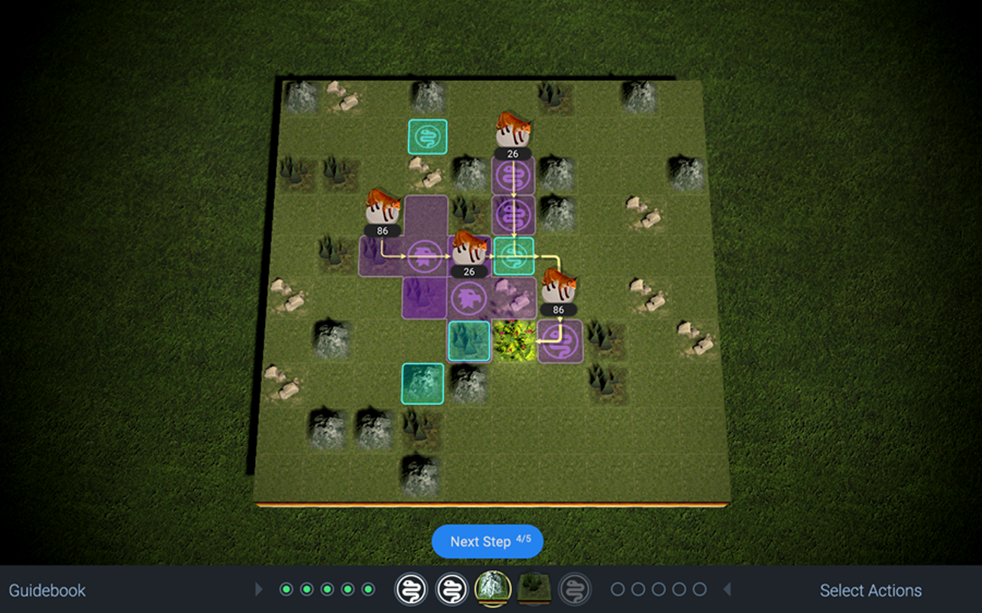
The McKinsey digital assessment is played on a desktop rather than a smartphone like other types of games. It looks and feels like a PC game similar to those that were popular 15 years ago such as SIMs and is highly intuitive for the user to navigate.
Structure of the McKinsey Digital Assessment
In the McKinsey digital assessment, candidates have around 70 minutes to complete two game scenarios (tutorial time is excluded), selected from a pool of six known ones.
The six possible scenarios in the digital assessment that have been published by McKinsey include:
Scenario 1: Ecosystem Management
Objective: To build a self-sustaining natural ecosystem in a coral reef or a mountain range.
The candidate is provided with a selection of different animals and plants, each requiring and providing varying amounts of nutrients, as well as needing different living conditions. The candidate must assess the benefits of each and select an optimal combination of species and location that will ensure a sustainable ecosystem.
The candidate needs to build a sustainable chain of 8 species in order to successfully pass this game.
Scenario 2: Plant Defense
Objective: To protect an endangered species of plant from incoming invaders.
The routes of invaders are shown on a grid that increases in size during the game. Using the combination of a limited number of defenders (i.e., predators that hunt the invaders) and terrain (which slows down or blocks the path of the invaders), the user must prevent the plant in danger from being reached by the invader for as long as possible.
Scenario 3: Disaster Management
Objective: To identify an incoming natural disaster and take necessary evasive action for a group of animals.
Symptoms of a natural disaster are presented to the candidate such as wind speed, precipitation, and air temperature. Using this information, the candidate has to identify a natural disaster. Each type of disaster has a different expected impact on the island, where a group of animals lives.
Knowing this, the candidate must choose where to relocate the group of animals whilst ensuring they will be protected, sheltered, fed, and watered sustainably in the new location.
Scenario 4: Disease Management
Objective: To identify a mysterious disease spreading through a population and the animals that could be affected by it.
An animal population is showing symptoms of a disease. Based on the symptoms detected, the candidate must conclude which animals will be affected next and the rules that will lead to the infection.
There are usually two maps in this game, with the second one being substantially more complex since the number of variables for each animal will increase.
Scenario 5: Migration Management
Objective: To migrate a group of animals on a path from point A to point B while maximizing the number of animals surviving.
The candidate starts each map with a set of allocated resources (e.g., apples, water, nuts) and is presented with many branching paths to help their animal group reach the final destination. At each step, a certain number of resources will be consumed; the candidate will also be able to collect additional resources and animals at each step. If the candidate has insufficient resources for a specific step, a few animals will be lost.
With this in mind, the candidate must identify the resources needed for survival, plan the path to collect those resources and minimize movements to ultimately reach the final destination with as many animals as possible.
Scenario 6: Redrock Study
Objective: To select relevant information out of text, graphs, and tables provided and answer a few numerical questions.
This is the new entry between the McKinsey games as it was first launched in 2022.
The candidate will see information related to a few animal species, including text paragraphs, graphs, and numbers, and will have to select relevant parts to use for his/her research. The information can be dragged and dropped into a separate part of the screen and collected in a research journal.
After the research phase, the candidate will have to use the information collected to answer three quantitative questions related to the animal species.
Top Tips For the McKinsey Digital Assessment










